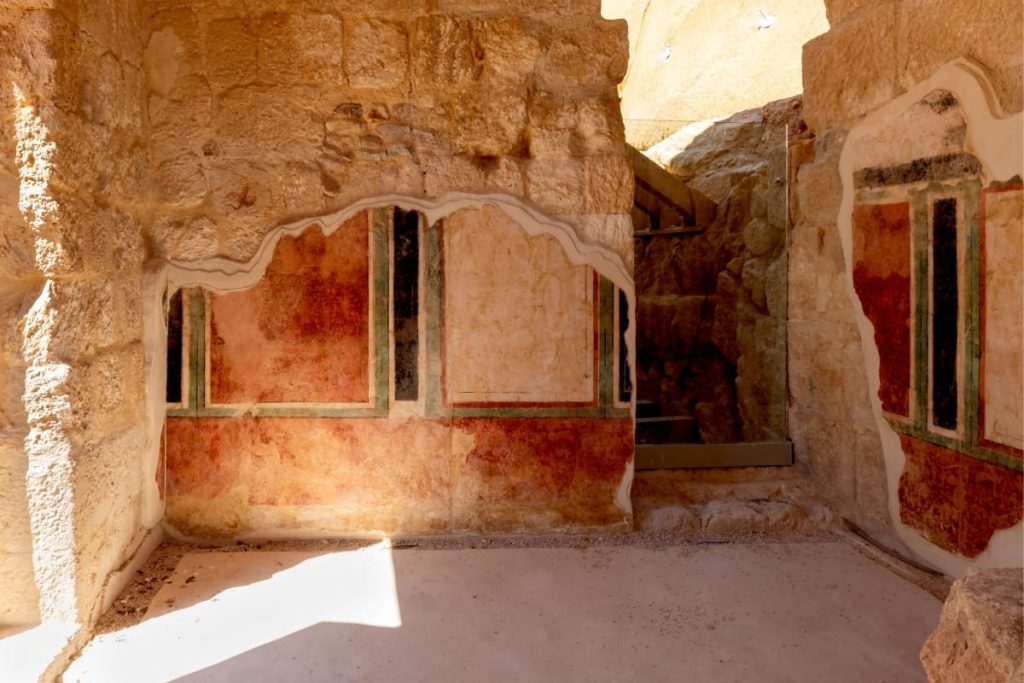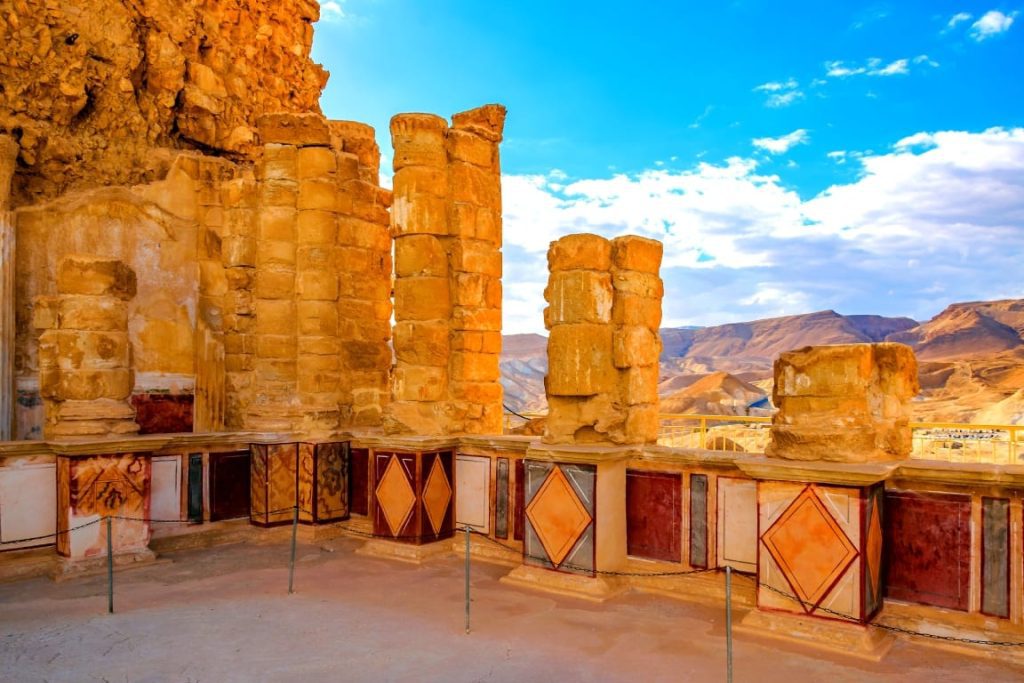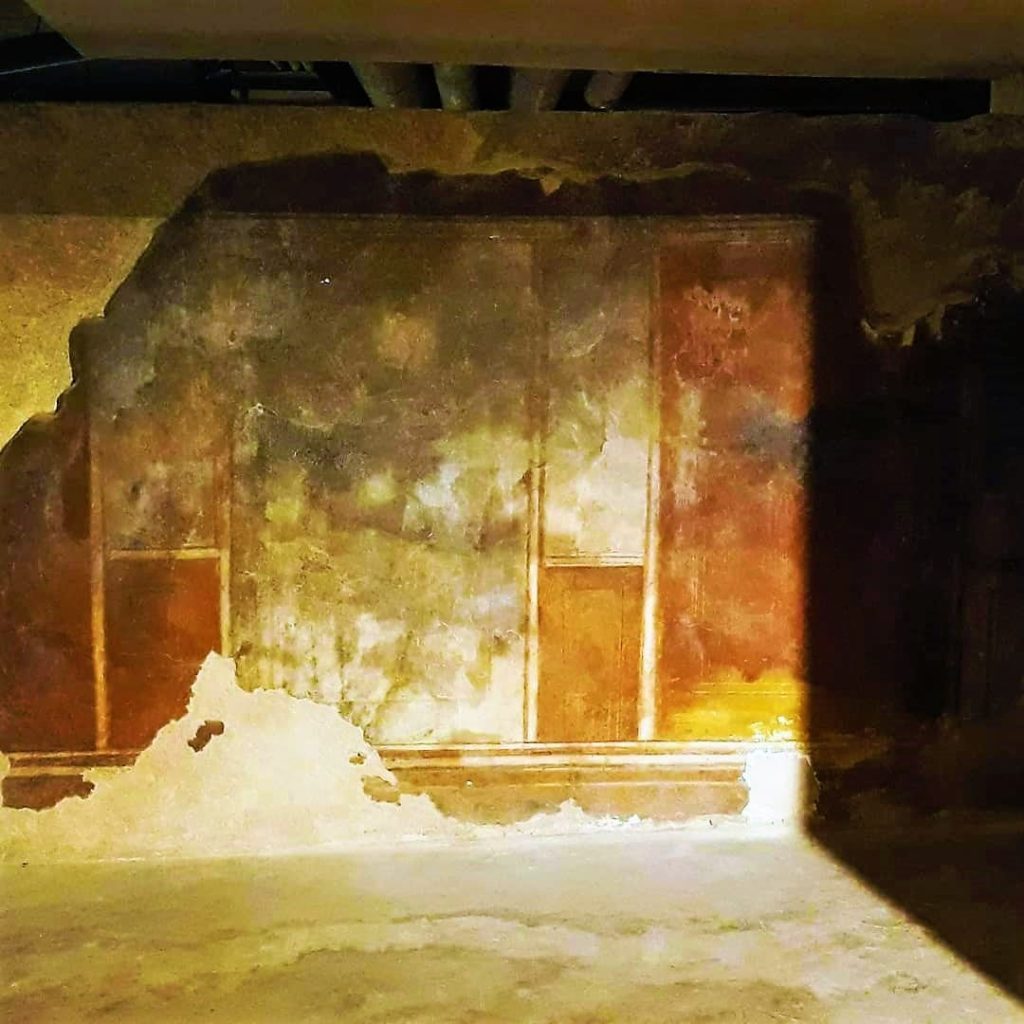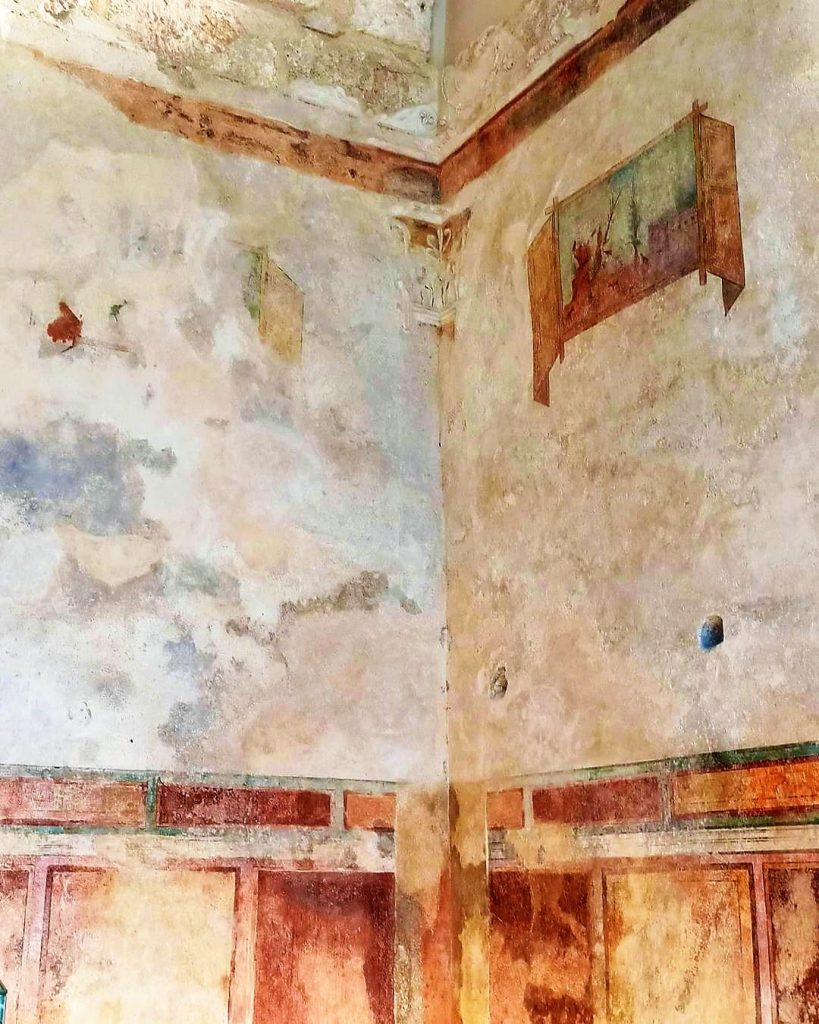Roman wall painting styles are seen all over the Holy Land. This is especially true when you visit King Herod’s Palaces and Jewish homes dated to the Roman Period.Paintings from antiquity rarely survive. After all, paint is a much less durable medium than stone or bronze sculpture. But thanks to the ancient Roman city of Pompeii, we can trace the history of Roman wall painting. Since the entire city was buried in volcanic ash in 79 CE. When Mount Vesuvius erupted; thus preserving the rich colors in the paintings in the houses until their rediscovery. These paintings represent an uninterrupted sequence of two centuries of evidence.

ROMAN FRESCOS AT HERODIUM NATIONAL PARK
Roman Wall Paintings Styles: Pompeian Styles
Why Pompeii?
And thanks to August Mau, a nineteenth-century German scholar; that we have a classification of four styles of Pompeian wall painting. The wall painting styles have allowed art historians to delineate the various phases of interior decoration in the centuries leading up to the eruption of Vesuvius in 79 C.E. Which on one hand destroyed the city, but preserved the paintings; and between stylistic shifts in Roman art. In the succession of styles, there is a reiteration of stylistic themes. The paintings also tell a great deal about the prosperity of the area and specific tastes during the times.
Roman Wall Paintings Styles: First Style – the Incrustation Style
So Mau called the First Style the “Incrustation Style”. The First Style is characterized by colorful patchwork walls of brightly painted faux marble. Each rectangle of painted “marble” was connected by stucco moldings that added a three-dimensional effect. In temples and other official buildings, the Romans used costly imported marbles in a variety of colors to decorate the walls. But ordinary Romans could not afford such expenses.

ROMAN PAINTING STYLES AS SEEN AT HEROD’S LOWER PALACE, MASDA NATIONAL PARK
So they decorated their homes with painted imitations of the luxurious yellow; purple and pink marbles. In fact, painters became so skilled at imitating certain marbles that the large rectangular slabs were rendered on the wall marbled and veined. Just like real pieces of stone.
Roman Wall Paintings Styles: Second Style – The Architectural Style
The architectural style or ‘illusionism’ dominated the 1st century BCE. The walls were decorated with architectural features; and trompe l’oeil (trick of the eye) compositions. Early on, elements of this style are reminiscent of the First Style. But this slowly starts to be substituted element by element. So this technique consists of highlighting elements to pass them off as three-dimensional realities. For example, columns, dividing the wall space into zones; and was a method widely used by the Romans.
Glass Production in the Ancient World
In other words, while the First Style embraced the flatness of the wall. In contrast, the Second Style attempted to trick the viewer into believing that they were looking through a window; by painting illusionistic images. As Mau’s name for the Second Style implies: architectural elements drive the paintings. And creating fantastic images filled with columns, buildings, and stoas.
In summary: many paintings from this style involved illusions of imaginary scenes. Painters wanted to give off the illusion that the viewer was looking through a window at the scenery depicted. Also, they added objects that are commonly seen in real life such as vases; or shelves along with items that appeared to be sticking out of the wall. This style was intended for viewers to feel as though the actions in the painting were taking place around them.
Images and landscapes began to be introduced to the first style around 90 BCE. and gained ground from 70 BCE. onwards; along with illusionistic and architectonic motives. The Decoration had to give the greatest possible impression of depth. Imitations of images appeared, at first in the higher section, then (after 50 BCE) in the background of landscapes which provided a stage for mythological stories, theatrical masks, or decorations.
Roman Wall Paintings Styles: The Style Under the Reign of Augustus
During the reign of Augustus, the style evolved. False architectural elements opened up wide expanses with which to paint artistic compositions. A structure inspired by stage sets developed, whereby one large central tableau is flanked by two smaller ones.
In this style, the illusionistic tendency continued; with a ‘breaking up’ of walls with painted architectural elements or scenes. The landscape elements eventually took over to cover the entire wall; with no framing device. So it looked to the viewer as if he or she was merely looking out of a room onto a real scene.
Basically, the more developed Second Style was the antithesis of the First Style. Instead of confining and strengthening the walls. The goal was to break down the wall to show scenes of nature and the outside world. Much of the depth of the mature Second Style comes from the use of an aerial (atmospheric) perspective that blurred the appearance of objects further away. Thus, the foreground is rather precise while the background is somewhat indistinctly purple, blue, and gray. Fashionable particularly from the 40s BCE., onwards, it began to wane in the final decades BCE.

ROMAN FRESCOS FOUND AT THE HERODIAN MANSIONS IN 2ND TEMPLE JERUSAELM
Roman Wall Paintings Styles: Third Style – The Ornamental Style
The Third style, or ornate style, was popular around 20–10 BC as a reaction to the austerity of the previous period. It leaves room for more figurative and colorful decoration; with an overall more ornamental feeling, and often presents great finesse in execution. This style is typically noted as simplistically elegant. The Roman architect Vitruvius was certainly not a fan of Third Style painting, and he criticized the paintings for representing monstrosities rather than real things:
“[…] For instance, reeds are put in the place of columns; fluted appendages with curly leaves, and volutes. Instead of pediments, candelabra supporting representations of shrines. And on top of their pediments numerous tender stalks and volutes growing up from the roots and having human figures senselessly seated upon them […]” (Vitr.De arch.VII.5.3)
The Third Style also saw the introduction of Egyptian themes and imagery, including scenes of the Nile. As well as Egyptian deities and motifs. Plants and characteristically Egyptian animals were often introduced, part of the Egyptomania in Roman art. After Augustus’ defeat of Cleopatra and annexation of Egypt in 30 BCE.
In this particular style, more wall space is left plainly colored, with no design. When designs were present; they tended to be small; plain pictures or scenes such as candelabra or fluted appendages. Delicate motifs of birds or semi-fantastical animals appeared in the background. These paintings were decorated with delicate linear fantasies. Predominantly monochromatic, that replaced the three-dimensional worlds of the Second Style. It was found in Rome until 40 CE, and in the Pompeii area until 60 CE.
Roman Wall Paintings Styles: Fourth Style – The Intricate Style
Characterized as a Baroque reaction to the Third Style’s mannerism. The Fourth Style in Roman wall painting (c. 60–79 AD) is generally less ornamented than its predecessor. However, the style was much more complex. It revives large-scale narrative painting and panoramic vistas. While retaining the architectural details of the Second and First Styles. In the Julio-Claudian phase (c. 20–54 CE.), a textile-like quality dominates. And tendrils seem to connect all the elements on the wall. The colors warm up once again. And they are used to advantage in the depiction of scenes drawn from mythology; landscapes; and other images.
Intricate paintings appeared busier and used the wall in its entirety to be complete. The overall feeling of the walls typically formed a mosaic of framed pictures. The lower zones of these walls tended to be composed of the First Style. Panels were also used with floral designs on the walls.
In describing what we call the Fourth Style; Pliny the Elder said that it was developed by a rather eccentric, albeit talented, painter named Famulus who decorated Nero’s famous Golden Palace. (Pl.NH XXXV.120).








